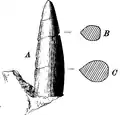Clepsysaurus
Clepsysaurus is a dubious genus of extinct archosaur described by Isaac Lea in 1851[1] from remains discovered in the Carnian[2] Passaic Formation of Lehigh County, Pennsylvania.[1] Two species are known: C. pennsylvanicus (the type species)[1] and C. veatleianus.[3] The holotype of C. pennsylvanicus, ANSP 9526, 9555-71, 9594-5, consists of teeth, ribs and vertebrae,[4] while the holotype of C. veatleianus, AMNH 2331, consists of a single tooth, with AMNH 2330, a tooth, as a referred specimen.[3] Other specimens of C. pennsylvanicus are known, including ANSP 15071 (a left anterior dentary with 23 teeth, a right dentary with 30 teeth and a portion of the right temporal region) and AMNH 2337 (a single tooth).[5]
| Clepsysaurus | |
|---|---|
.png.webp) | |
| Holotype tooth (AMNH 2331) of C. veatleianus seen from two different angles | |
| Scientific classification | |
| Kingdom: | |
| Phylum: | |
| Class: | |
| (unranked): | |
| Genus: | †Clepsysaurus Lea, 1851 |
| Type species | |
| †Clepsysaurus pennsylvanicus Lea, 1851 | |
| Other species | |
| |
| Synonyms | |
Clepsysaurus was traditionally classed as a sauropodomorph,[3][4] but more recent studies indicate that it was either a dubious basal archosaur[6] or a member of the Phytosauria.[7] Clepsysaurus was eventually seen as a synonym of either the dubious archosaur Palaeosaurus or the sauropodomorph Anchisaurus, but Clepsysaurus was eventually resurrected as a valid, but dubious, genus.[4][7][8]
Gallery
 AMNH 2330, a tooth referred to C. veatleianus
AMNH 2330, a tooth referred to C. veatleianus C. pennsylvanicus tooth AMNH 3227 seen from two different angles
C. pennsylvanicus tooth AMNH 3227 seen from two different angles
References
- Lea, I. (1851). "Remarks on Clepsysaurus pennsylvanicus". Proceedings of the Academy of Natural Sciences of Philadelphia. 18 (205).
- Berg, T.M.; et al. (1983). "Stratigraphic Correlation Chart of Pennsylvania: G75". Pennsylvania Geologic Survey, Harrisburg, Pennsylvania.
- Cope, E. D. (1877). "Descriptions of extinct Vertebrata from the Permian and Triassic formations of the United States". Proceedings of the American Philosophical Society. 17 (100): 182–193. JSTOR 982295.
- Spamer, Earle E.; Daeschler, Edward; Vostreys-Shapiro, L. Gay (1995). A Study of Fossil Vertebrate Types in the Academy of Natural Sciences of Philadelphia: Taxonomic, Systematic, and Historical Perspectives. Philadelphia Academy of Natural Sciences. ISBN 978-0-910006-51-4.
- von Huene, F. (1921). "Reptilian and stegocephalian remains from the Triassic of Pennsylvania in the Cope Collection". Bulletin of the AMNH. 44. article 19.
- Nesbitt, Sterling J.; Desojo, Julia B.; Irmis, Randall B. (2013). "Anatomy, phylogeny and palaeobiology of early archosaurs and their kin". Geological Society, London, Special Publications. 379 (1): 1–7. doi:10.1144/sp379.21. ISSN 0305-8719. S2CID 85154302.
- Stocker, M. R.; Butler, R. J. (2013). "Phytosauria". In Nesitt, S. J.; Desojo, J. B.; Irmis, R. B. (eds.). Anatomy, Phylogeny and Palaeobiology of Early Archosaurs and their Kin. Geological Society, London, Special Publications. p. 379.
- "Clepsysaurus". Paleofile. Retrieved 2 November 2020.